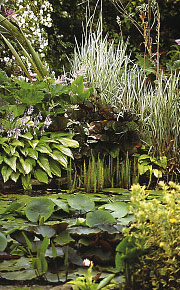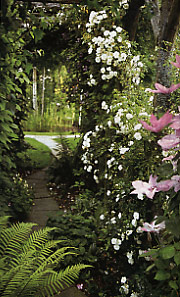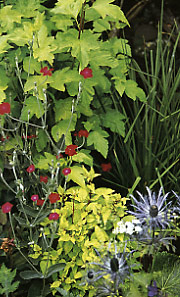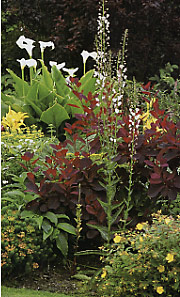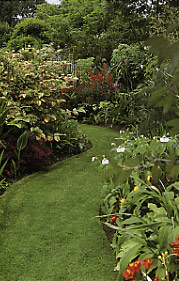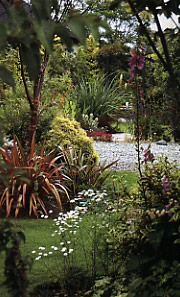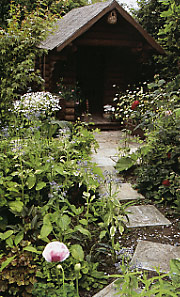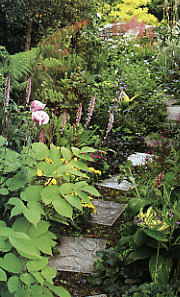By name and by nature, this is a new garden and new territory for Deborah and Martin Begley. But what an achievement it is in such a short space of time. Margaret O'Brien visited and was fascinated.
FINDING THE BEGLEYS' HOUSE was not easy — but I was guided there, through a maze of twists and turns of Limerick's country roads, by Martin Begley Glass fingerpost signs. A quick glimpse in the gateway reassured me that I had arrived in the correct place. The warmest of welcomes from Deborah and Martin made me feel instantly at home, as so often happens when gardeners get together, like long-lost soul mates. Deborah is the plantswoman and Martin augments her love of plants with his construction skills.
Although they moved into the house in 1991, gardening did not really start until 1995, when, as Deborah says, "I started the garden, slowly at first and Martin caught the bug by mowing the grass initially and then started to construct the various features around the garden. From that point the garden really took off." Indeed the half-acre garden seems much bigger and has been cleverly designed, so as to hide many of the features from each other. Each turn reveals new features with their associated plantings. There are lots of unusual plants, with so many different cultivars that my excitement grows at the turn of every corner. Here is a lady who knows her proverbial onions!
The sound of water is always attractive and as we walk towards the first pool, which Deborah refers to as her wildlife pond, a cascade is revealed, springing from a hidden source under the penny bridge, the path surface of which is studded with old pennies to bring good luck, and judging by the lush plantings of hosta, astilbe, gardener's garters and ferns, the charm is certainly working. Looking at Deborah's planting, one would not suspect that winter temperatures regularly plummet to lows of minus 10° Celsius or that the original soil is heavy clay with a neutral pH.
A most delightful woodland walk extends from the wildlife pond, past a hobbit-style log house and on towards a perfect sward of dark grass, sharply edged. Shade lovers abound here and include Dienanthe coerulea with a sweet blue flower that warranted such close inspection as to have us both on our knees. A variegated sowthistle by the delightful name of 'Custard and Green' caught the eye. Deborah remarks, "I always remove the flowers from it, as I grow it purely for its foliage — did I mention I have a thing for variegated foliage plants? I also have a variegated rose called Rosa 'Curiosity', a tomato, horseradish, sweet corn and kale." The outstanding foliage of Artemisia lactiflora 'Guizhou' is carried on dark stems and has the added bonus of white flowers that lighten up the shade here. I hadn't seen Geranium thurstonianum since I grew it in my own previous garden; it was like meeting an old friend. The dark pink petals are narrow and widely spaced, giving it an unusual appearance for a hardy geranium, but it is delightful as a ground cover here in the shade. American pokeweed, Phytolacca americana, is a shrub-like perennial with inky black berries that self-sow easily, growing very happily with a fabulous form of Tetracentron sinense, the leaves of which hang down like washing on a line. The edgeworthia treated Deborah to its show of drooping flowers on bare branches this year, much to her delight, although she favours foliage over flowers in general in the garden, but even with foliage plants Deborah is strict. "There is a dilemma with the golden robinia, however. I think its colour is a little too brash for its companion planting." The 'queen of the umbels', Selinum wallichianum, is anything but brash. Its soft ferny foliage is a spring delight and its creamy white flowers, in typical umbels, are a treat in August. It is placed to great effect beside Sambucus 'Black Beauty', which Deborah feels is superior in every way to the similar but better known S. 'Guincho Purple'.
Roses feature in the garden in general and are used as part of the mixed planting in a way that they look best. Shrub roses, and David Austin roses in particular, .are favoured over hybrid teas or floribundas Rosa 'Ferdinand Pichard' is a hybrid perpetual, well scented with white/cerise stripped flowers, which grows to 1.5 metres, and the shrub rose, Rosa 'Nevada', is taller, spectacular with large creamy white flowers. A tulip tree, Liriodendron tulipifera, plays host to a cream cascade of R. 'Sharifa Asma'. Clematis also feature extensively and C. akebioides 'Alba Luxurians' looked dainty in the late summer border. Meconopsis abound in the woodland garden too and Deborah finds the only way to grow them is from seed, then if you lose one or two, you don't feel their loss so much.
Standing looking at the well, on a piece of meticulously kept lawn, I am aware of a delightful contrast to the woodland garden. Here the sound of the cascade is hidden from view. At the edge of the border stands a particularly good form of the pheasant's berry, Lycesteria formosa, again grown from seed, but well worth propagating. A spotless arch of mixed phormiums — 'Jester', 'Yellow Wave' and 'Tricolor' — contrast beautifully with the smooth, mahogany-barked Prunus serrula in the middle. "Many people ask me how I keep my phormiums looking so well and are surprised to know that in spring I groom them by taking off every tatty leaf — grooming of plants is so important, don't you think?" I agree wholeheartedly as we launch into greater detail on the subject. I tell her of a friend who received a present of a large amount of Helleborus orientalis hybrids, unwanted, because the flowers were so hidden by foliage! She now cuts down all the foliage in late December before the blossoms emerge and enjoys a wonderful winter show. It's all down to grooming!
Foliage is noticeable all around the garden, in great combinations. Cotinus coggygria 'Grace', a large-leaved, dark purple variety, and Rodgersia podophylla, with dark shading on the leaves, look well together, with the smooth texture of the leaf of the former contrasted by the quilted texture of the latter. I was delighted to see two plants of a notable lime tree, Tilia henryana, one of Augustine Henry's introductions. They have deep serrations on the leaf margins and, although they are too young to flower yet, the impressive pendular flowers will be a bonus worth waiting for. These two plants replaced an earlier planting of flowering cherries, the trunks of which have now gone to the woodturner. The lovely white birch, Betula 'White Light', has the whitest bark of all — the bark is washed gently with a sponge and a little washing up liquid in water each year to keep it clear of algae.
A raised circular pool at the centre of the area is reached by arch-covered paths on two sides and surrounded by mixed planting. The front gardens contain two perfect lawns, one oval and the other oblong. Eryngium pandanifolium, looking as though it belongs in the Mediterranean and not County Limerick, stands sentinel at the entrance to the oval lawn. Its candelabra of flowers can top three metres in height, but the grey sword-shaped leaves are reason enough for growing it. The dark purple foliage and pale pink flowers of Geranium 'Persian Carpet' work well as ground cover and it is surprising to note that it comes true from seed. Helianthus salicifolius is grown purely for its linear foliage. The daintiest of summer-flowering clematis twines over the arch — C. 'My Angel' is aptly named. It resembles the winter-flowering C. cirrhosa flower in shape but with a lemon-yellow inside to the petals. I was very taken with it, so much so that I received one as a present on my departure!
On the other arch, Clematis viticella 'Purpurea Plena Elegans' was stunning and I noticed Clematis florida 'Sieboldii' looking far healthier than I could ever seem to manage outdoors. A dark, almost black Scabiosa atropurpurea 'Ace of Spades', grown from Thomson and Morgan seed, could not be surpassed. Nearby in wonderful contrast was the most perfect comfrey I had ever laid eyes on in August. Deborah let me in on her secret. "This is Symphytum uplandicum 'Axminster Gold'. After the first flush of pinkish blue flowers is over, I cut it down to the ground. The second growth of leaves produces no flowers, but the leaves grow larger and last into the autumn."
Across the second lawn to the sound of gentle water from a cobble fountain is the grey garden, dominated by a large Abies koreana, the lovely Korean fir. On through a shady courtyard, which might have been a dull area but is certainly nothing of the sort. An old door — leading nowhere — is set in the hedge here and back-lit by natural light through one of Martin's wonderful pieces of stained glass. This is a spring garden and is gently quiet for this time of year. As we turn a corner to the side of the house, the propagation shed is revealed and what a revelation. This is a potting shed extraordinaire with stained glass windows and a seed-growing system of scientific complexity. Deborah follows an American professor, Norm C. Deno's method of seed production, which is rather fascinating. Seed is chitted on moist tissues (germinated prior to sowing) and placed in sealed polythene bags until germination takes place. Some seeds, like the giant lily Cardiocrinum giganteum, require a cold period and are refrigerated for three months to break dormancy. The chitted seed is placed in compost in seed trays and put in a box that is lit with four fluorescent tubes to emulate daylight. Seed trays are placed fifty centimetres away from the light source. In this way seeds can be started in November and seedlings given all the light they need for sturdy growth until natural light levels improve.
Two cold glasshouses next door are crammed with young plants, which are hardened off before planting out or selling in the nursery. The wooden panels that hide the glasshouses from the rear garden contain delightful feature panels of arisaemas in stained glass, a gift from Martin. The rear garden holds yet more delights. The pond was the first thing that was put in seven years ago and now looks satisfyingly mature. It is bounded on one side by the exotic autumn border. "This is my 'wow' part of the garden," explains Deborah, "it is lush and contains plants which need a lot of winter care. I have six different ginger lilies — hedychiums — which are mulched with twenty-five centimetres of home-made compost each winter to protect them from frost." Another ginger family member, Cautleya spicata, grows happily from Himalayan seed, near Impatiens tinctoria, a tall busy lizzie with magenta-marked white flowers.
The voodoo lily, Sauromatum venosum, flowers prior to producing foliage and regularly survives temperatures of minus 10° Celsius. Its singularly amazing leaf is carried on a dark mottled stem. The variegated Japanese knotweed grows here, a little to my surprise, given its invasive nature, but Deborah reassures me it is always kept in a pot. It is a great foliage plant, however, and when kept in check it is very decorative. A new raised bed made of cut stone by Martin is home to many smaller young treasures, including many aroids — members of the arum family — and twelve species of paris, related to trillium, the wood lilies. The initial plantings of trees and shrubs have provided an ideal microclimate for Deborah's current passion for members of the Arisaema genus. "Arisaemas are showstoppers that offer originality in leaf and fruit. The stems are wonderfully marked and you can have them in bloom from February to August if you choose from the different species." As I gaze with wonder at the leaf of Arisaema consanguineum, Deborah describes
it as, "a common variety that comes easily from seed ami builds up a large corm as the years pass by. It can reach heights of 1.5 metres when mature. I have around 70 different species of arisaema around the garden and grow most from seed — in fact it was my passion for growing from seed and producing an overload of plants that led me to start my nursery, Terra Nova Plants, which now extends to a mail order section as well." None of Deborah's plants can be referred to as common, indeed exactly the opposite is the case.
A pergola leads to a delightfully simple ring of white-stemmed birch trees. The shape of the ring is echoed by a circle of Verbena bonariensis, its small purple flowers airily held on vertical stiff stems. The two circles have a fairy-like quality about them and the simplicity of design is startling. A path leads to a hidden seat for quiet contemplation. Deborah allows no space for 'drabby plants' and every inch of this garden is intensively planted — so much so that the boiler room roof has recently been given a roof garden too! ■
Terra Nova is open by appointment only. Tel. 063 90744.

|
|
![]()
